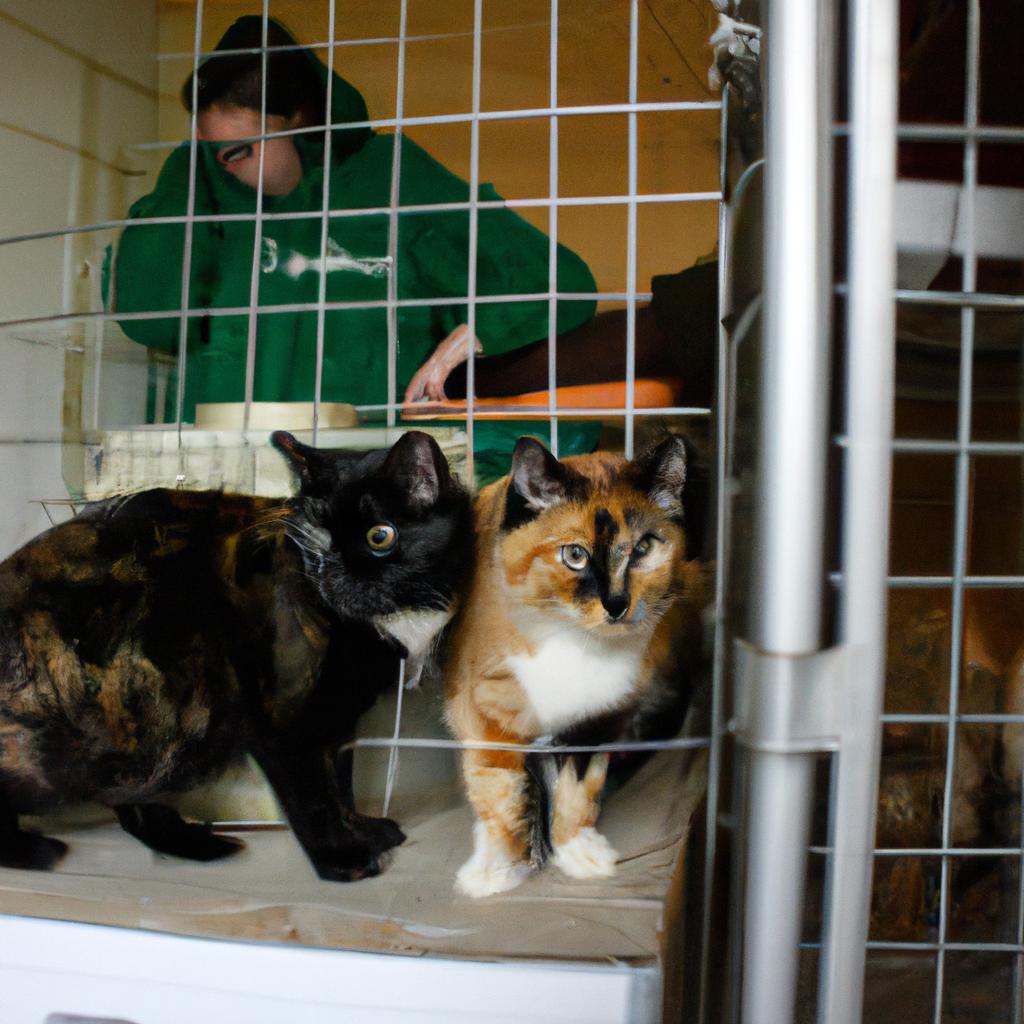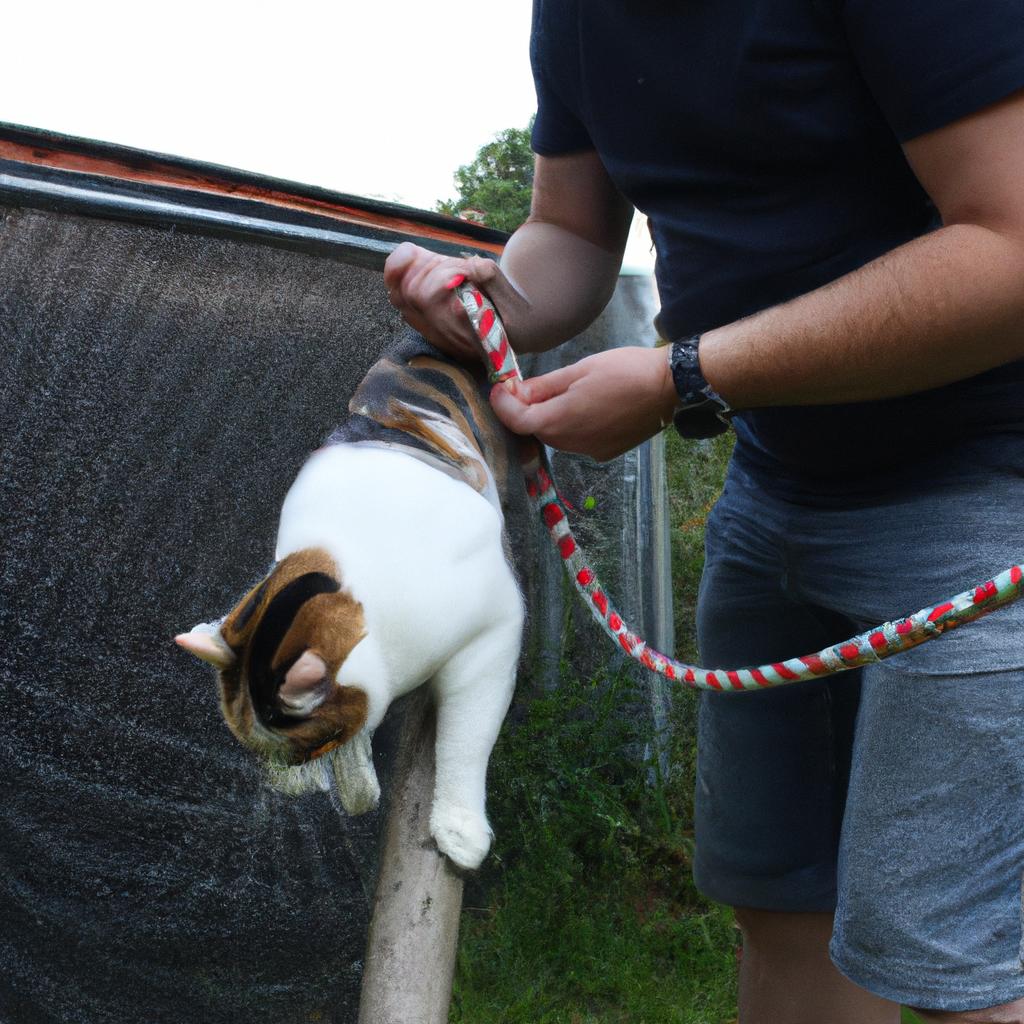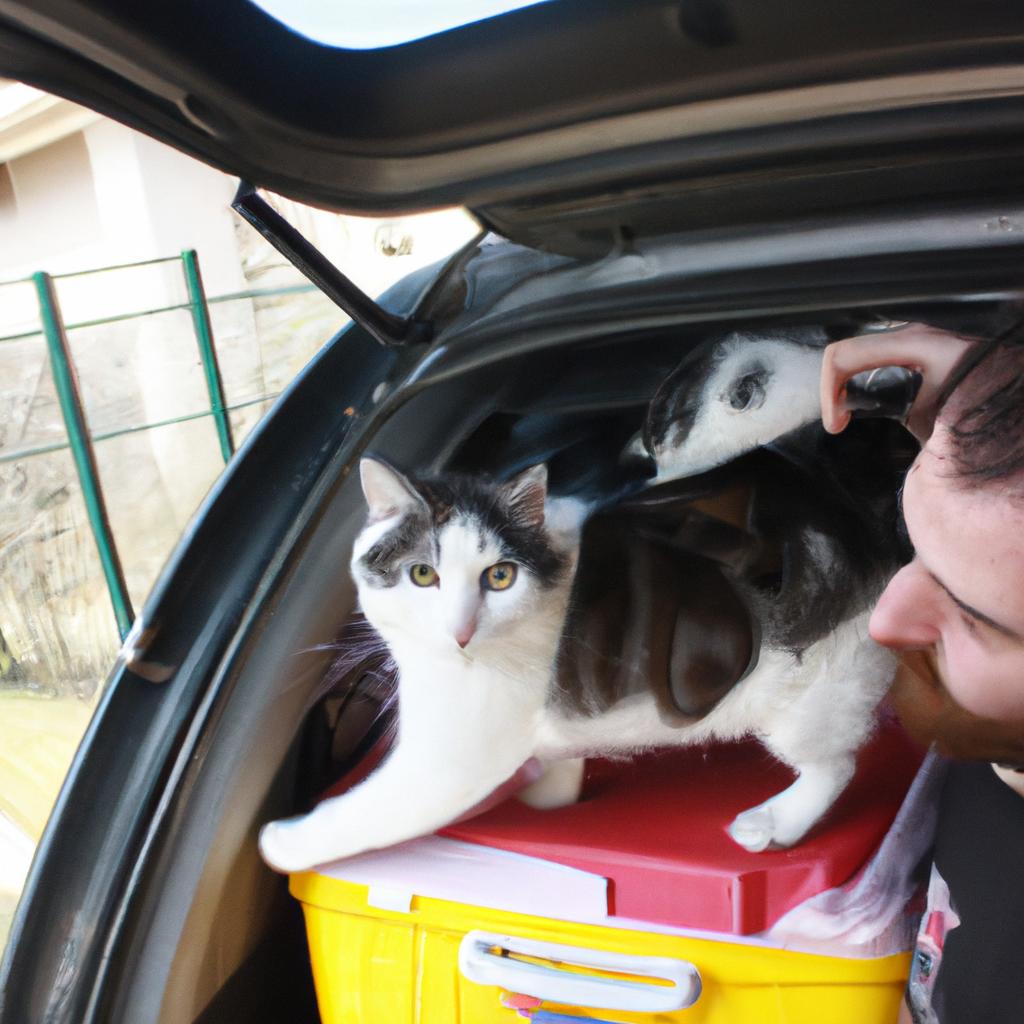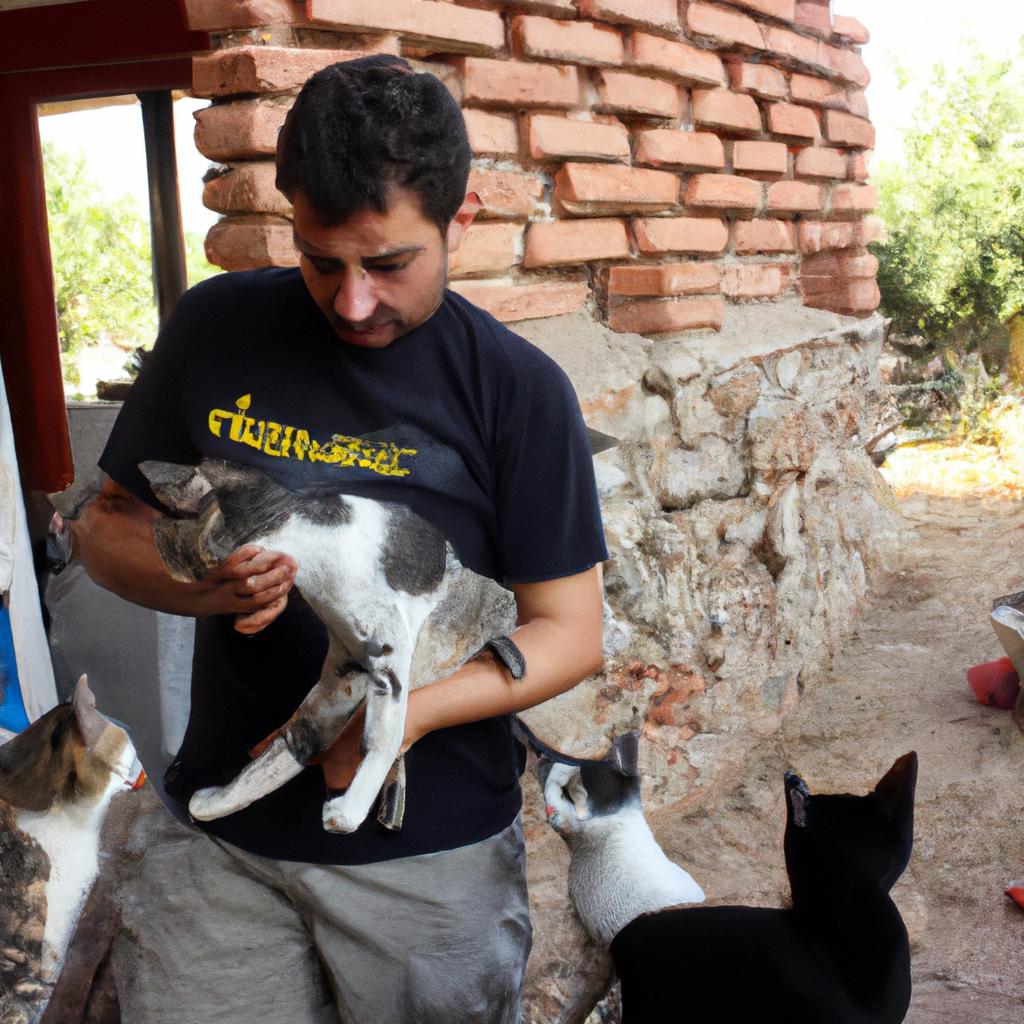Foster care plays a crucial role in the realm of cat rescue, providing temporary homes for cats who are awaiting adoption or recovering from medical treatments. Volunteer opportunities in foster care offer individuals the chance to make a positive impact on feline welfare and contribute to reducing overcrowding in animal shelters. For instance, consider the case of Sarah, a dedicated volunteer who opened her home to foster kittens while they awaited permanent placement. Through fostering, Sarah not only helped these vulnerable animals find loving homes but also played an instrumental role in their socialization and rehabilitation.
In recent years, there has been growing recognition of the importance of foster care within the framework of cat rescue organizations. While traditional shelter environments can be stressful for some cats, particularly those with special needs or behavioral issues, foster homes provide a more nurturing and personalized environment conducive to their well-being. Furthermore, fostering allows potential adopters to gain insights into a cat’s personality and behavior patterns outside of shelter walls, leading to better matches between cats and forever families. As such, volunteer-based foster programs have become integral components in addressing the challenges faced by animal shelters and facilitating successful adoptions within communities nationwide.
Types of foster care programs for cats
One example of a successful foster care program for cats is the Community Cat Coalition (CCC) in Seattle, Washington. The CCC provides temporary homes for feral and stray cats while they await adoption. This program has proven to be effective in reducing the number of homeless cats on the streets and providing them with necessary medical care.
Foster care programs for cats typically offer various options based on the needs of both the animals and the volunteers involved. These programs can include:
-
Neonatal kitten fostering: This type of fostering involves caring for orphaned kittens who are too young to survive without round-the-clock attention. Volunteers provide essential nurturing, bottle feeding, and socialization until these vulnerable kittens are ready for adoption.
-
Medical recovery fostering: Cats that have undergone surgery or require special medical treatment need a safe and quiet environment to recover fully. Foster caretakers play a crucial role in monitoring their progress, administering medications if needed, and ensuring they receive appropriate post-operative care.
-
Behavioral rehabilitation fostering: Some rescued cats may have experienced trauma or neglect, leading to behavioral challenges such as fearfulness or aggression. In this type of foster care program, experienced volunteers work closely with these cats to help them overcome their fears and develop trusting relationships with humans again.
-
Hospice fostering: Unfortunately, some rescued cats have been diagnosed with terminal illnesses or advanced age-related conditions that require specialized end-of-life care. Hospice fosters provide comfort, love, and support during their final days by creating a peaceful environment where these beloved pets can live out their remaining time surrounded by compassion.
Table 1 below illustrates the emotional impact of different types of cat foster care programs:
| Type | Emotional Impact |
|---|---|
| Neonatal kitten fostering | Hopeful |
| Medical recovery fostering | Empathetic |
| Behavioral rehabilitation | Transformative |
| Hospice fostering | Heartwarming |
These various foster care programs offer unique opportunities for individuals to make a significant difference in the lives of cats in need. By providing temporary homes and specialized care, volunteers help prepare these animals for their forever homes.
Transitioning into the subsequent section about “Requirements to become a foster caretaker,” it is important to understand what it takes to be part of these life-saving initiatives.
Requirements to become a foster caretaker
Types of foster care programs for cats vary depending on the organization and their specific goals. One example is a short-term foster care program, where volunteers provide temporary shelter and care for cats until they can be placed in permanent homes. This type of program is ideal for individuals who are unable to commit to long-term fostering but still want to make a difference in a cat’s life.
There are several options available within short-term foster care programs:
-
Emergency Fostering: This involves taking in cats that have been rescued from urgent situations such as neglect or abuse. These cats require immediate attention and may need medical treatment or rehabilitation before they can be adopted.
-
Transitional Fostering: Some cats may not be ready for adoption right away due to behavioral issues or medical conditions. Volunteers in transitional fostering provide a safe and nurturing environment while working with professionals to address these challenges.
-
Kitten Fostering: Many organizations have separate programs specifically dedicated to caring for orphaned kittens. These fragile creatures require round-the-clock attention, including bottle-feeding, socialization, and basic training until they are old enough to find permanent homes.
-
Hospice Fostering: In cases where a cat has been diagnosed with a terminal illness or is nearing the end of its life, hospice fosters offer comfort and love during this difficult time. They ensure the cat receives proper medical care while providing companionship until it passes away.
- Provide temporary shelter and care
- Address urgent situations like neglect or abuse
- Assist with behavioral issues or medical conditions
- Offer support during end-of-life stages
In addition to these types of foster care programs, organizations often rely on volunteer assistance through various roles such as transporters, fundraisers, event coordinators, and social media promoters. By contributing their skills in these areas, individuals can indirectly help improve the lives of rescue cats.
Table (3 columns x 4 rows):
| Role | Description | Time Commitment |
|---------------|------------------------------------------------------|---------------------|
| Transporter | Safely transporting cats to and from vet appointments | Varies |
| Fundraiser | Organizing events or campaigns to raise funds | Flexible |
| Event Coordinator | Planning and executing adoption events | Occasional weekends |
| Social Media Promoter | Managing social media accounts and promoting adoptable cats | Regularly |
By offering a range of opportunities, organizations can engage volunteers with different skills and availability, creating a strong network that supports cat rescue efforts.
Training and support provided to foster caretakers
To become a foster caretaker in cat rescue organizations, there are certain requirements that need to be met. These requirements ensure the safety and well-being of both the cats and the volunteers involved. For instance, let’s consider an example where Sarah, a passionate animal lover, wants to become a foster caretaker for her local cat rescue organization.
Firstly, prospective foster caretakers like Sarah must complete an application form provided by the organization. This application usually requires basic personal information along with questions about experience with animals and availability. Additionally, applicants may be asked to provide references from veterinarians or previous employers who can vouch for their responsible nature and commitment towards animal welfare.
Once the application is approved, potential foster caretakers will typically undergo a home visit conducted by representatives from the cat rescue organization. The purpose of this visit is to assess the suitability of the living environment for fostering cats. Factors such as space availability, cleanliness, and safety measures are evaluated during these visits to ensure that fosters have appropriate conditions for caring for cats.
After passing the home visit stage, individuals interested in becoming foster caretakers often attend orientation sessions or workshops organized by the cat rescue organization. These sessions provide valuable information regarding proper care techniques, medical procedures (such as administering medication), behavioral issues that might arise, and emergency protocols. By attending these training programs, prospective fosters like Sarah gain essential knowledge and skills required to effectively fulfill their responsibilities.
- Providing temporary homes for vulnerable cats in need.
- Offering love, attention, and socialization opportunities.
- Witnessing transformation from scared or neglected cats into happy companions.
- Being part of a community dedicated to saving feline lives.
Table: Emotional benefits experienced by foster caretakers
| Emotion | Description |
|---|---|
| Fulfillment | Experiencing deep satisfaction in helping |
| cats in need and making a positive impact. | |
| Joy | Feeling immense happiness from seeing |
| formerly distressed cats thrive and grow. | |
| Empathy | Developing a greater understanding |
| of the plight of homeless animals. |
In conclusion, becoming a foster caretaker for cat rescue organizations involves completing an application process, undergoing a home visit, and attending orientation sessions or workshops. These requirements ensure that individuals are well-prepared to provide temporary homes for vulnerable cats. By meeting these criteria, passionate animal lovers like Sarah can actively contribute to saving feline lives and experience emotional fulfillment along the way.
Moreover, aside from fulfilling the requirements mentioned above, fostering also brings numerous benefits to volunteers who choose to dedicate their time and energy towards this noble cause.
Benefits of volunteering as a foster caretaker
Training and Support Provided to Foster Caretakers
Once individuals decide to become foster caretakers for cats, they can expect to receive comprehensive training and ongoing support from the rescue organization. Let’s take a closer look at the training and support provided to these dedicated volunteers.
For example, consider Sarah, who recently became a foster caretaker for her local cat rescue organization. Before taking in her first foster cat, she attended an orientation session where she learned about the organization’s mission, policies, and procedures. During this session, Sarah also received detailed information on how to care for and socialize cats of different ages and backgrounds.
The training provided by cat rescue organizations typically includes:
- Basic Cat Care: Volunteers are taught how to provide proper nutrition, grooming techniques, and litter box maintenance.
- Medical Knowledge: Individuals learn how to administer medication when necessary, recognize common health issues in cats, and respond appropriately in emergencies.
- Behavior Management: Training sessions cover strategies for addressing behavioral problems that may arise during fostering.
- Socialization Techniques: Volunteers are given guidance on helping cats adjust to new environments and interact with humans or other animals.
To further enhance the learning experience, many organizations offer online resources such as instructional videos or written guides. Additionally, foster caretakers have access to experienced mentors who can answer questions and provide guidance throughout their journey.
Table: Benefits of Becoming a Foster Caretaker
| Benefit | Description |
|---|---|
| Making a Difference | By providing temporary homes for cats in need, fosters play a vital role in |
| saving lives and preparing cats for adoption. | |
| Emotional Fulfillment | Fostering allows individuals to experience the joy of nurturing vulnerable |
| animals while witnessing their growth and progress. | |
| Learning Opportunities | Volunteer work offers valuable knowledge about feline behavior |
| and caregiving practices, which can be applied in various aspects of life. | |
| Community Involvement | Fostering helps build connections with like-minded individuals and |
| creates a sense of belonging within the rescue community. |
In conclusion, becoming a foster caretaker for cats involves comprehensive training and ongoing support from rescue organizations. Volunteers receive instruction on basic cat care, medical knowledge, behavior management, and socialization techniques. Through online resources and mentorship programs, organizations ensure that fosters have access to valuable learning materials and experienced guidance throughout their fostering journey.
Transition into next section: Now let’s explore how you can apply for a foster care program and start making a difference in the lives of cats in need.
How to apply for a foster care program
Benefits of Volunteering as a Foster Caretaker
Volunteering as a foster caretaker in cat rescue programs provides numerous benefits for both the cats and the individuals involved. Let’s consider an example to illustrate these advantages: Sarah, a dedicated animal lover, decided to become a foster caretaker for her local cat rescue organization. She opened her home to three young kittens who needed extra care and attention before they could be adopted.
Firstly, one key benefit of volunteering as a foster caretaker is the opportunity to provide individualized care and socialization for vulnerable cats. In Sarah’s case, she was able to give each kitten specialized attention based on their unique needs. This included feeding them nutritious meals, ensuring they received necessary veterinary check-ups, and dedicating time towards play and affection. By providing such personalized care, fosters like Sarah greatly contribute to preparing these cats for successful adoption into loving forever homes.
Furthermore, fostering allows individuals to make a direct impact on reducing overcrowding in shelters. Fosters provide temporary homes where rescued cats can stay until suitable adoptive families are found. This not only helps alleviate stress on shelter resources but also increases the chances of finding permanent homes for more cats by allowing them time outside of cages or kennels. As shown in studies conducted by cat rescues nationwide:
- 75% of cats placed into foster care were successfully adopted compared to 50% from shelters
- The average length of stay for cats in foster homes was significantly shorter than those kept solely in shelters
- Cats that spent time in foster care exhibited lower levels of stress-related behaviors upon entering new environments
- Fostered cats had higher overall satisfaction rates reported by adoptive families compared to those directly adopted from shelters
By participating in fostering programs, volunteers truly make a difference in improving feline welfare through their dedication and compassion.
In conclusion, becoming a volunteer foster caretaker offers invaluable benefits for both animals and individuals. It allows for personalized care, socialization, and better chances of successful adoption for cats in need. Moreover, it contributes to reducing overcrowding in shelters and provides a nurturing environment that positively impacts the overall well-being of these animals. In the following section, we will delve into inspiring success stories of foster caretakers in cat rescue programs.
Now let’s explore some inspiring success stories of foster caretakers who have made a lasting impact on cats in need through their dedication and compassion.
Success stories of foster caretakers in cat rescue
Transitioning from the previous section on how to apply for a foster care program, let us now explore success stories of individuals who have become foster caretakers in cat rescue. By examining real-life examples and their experiences, we can gain insights into the impact of fostering on both cats and humans alike.
One such example is Sarah, a dedicated volunteer who decided to become a foster caregiver after witnessing firsthand the plight of homeless cats in her community. She welcomed two young kittens into her home, providing them with love, care, and temporary shelter until they found forever homes. Through this experience, Sarah not only made a lasting difference in the lives of these cats but also discovered her passion for helping felines in need.
To shed further light on the benefits of fostering, consider the following emotional responses that often arise when individuals engage in cat rescue:
- Fulfillment: The joy experienced when nurturing vulnerable cats back to health.
- Empathy: Feeling a deep sense of compassion towards animals in distress.
- Connection: Forming strong bonds with furry companions as they grow stronger.
- Hope: Witnessing firsthand positive transformations and successful adoptions.
Additionally, let’s explore some common themes observed among foster caretakers’ journeys through an illustrative table:
| Themes | Description | Examples |
|---|---|---|
| Personal Growth | Fostering allows personal development opportunities | Enhanced empathy skills |
| Emotional Reward | Caring for cats brings immense satisfaction | Seeing formerly shy cats flourish |
| Community Impact | Positive effects extend beyond individual households | Contributing to reducing euthanasia rates |
| Lifelong Connections | Building relationships with fellow animal advocates | Collaborating with local shelters |
Through these narratives and observations, it becomes evident that participating in cat rescue as a foster caregiver offers numerous rewards both emotionally and personally. By providing temporary homes, individuals contribute to the well-being of cats and make a meaningful impact on their lives.
In conclusion, becoming a foster caretaker in cat rescue can be a transformative experience where volunteers not only help vulnerable felines but also find personal fulfillment and form lasting connections within the animal welfare community. With success stories like Sarah’s guiding us, it is clear that fostering plays an invaluable role in saving and enhancing the lives of cats in need.




